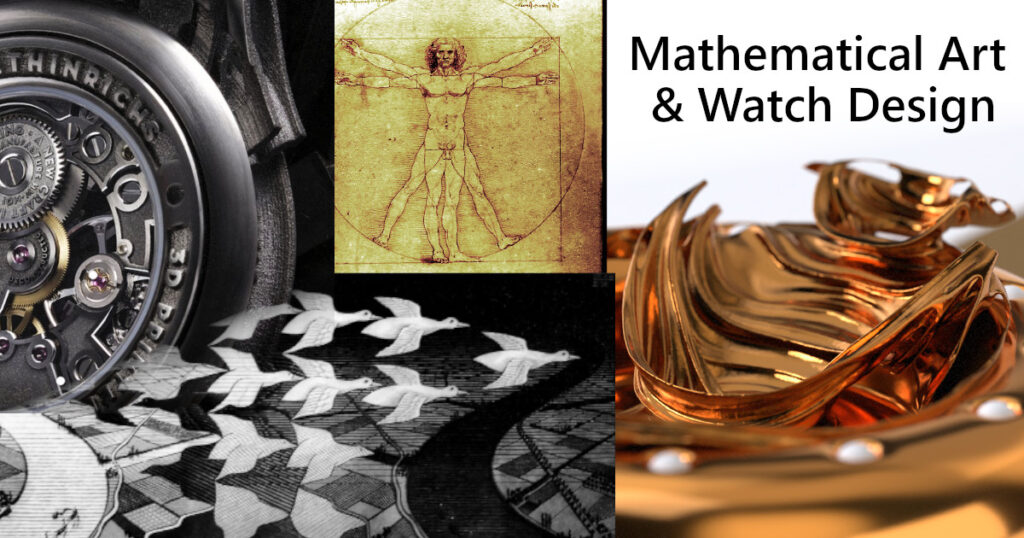
Sections of this article:
- Mathematical Art: How Mathematics Can Be Used In Art.
- Artists Who Use Mathematics
- Mathematical Art And Watchmaking.
- The Transition Of Focus From Simple Symbols To Complex Reality
- Complex Mathematics In Watch Visual Design
Introduction.
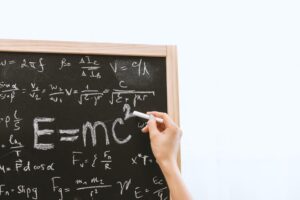
Mathematics, with a known history going back 4,000 years to Mesopotamia, is the science of numbers, structure, and space.
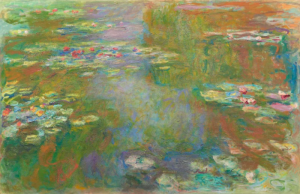
Art relates to creativity (making something new) and aesthetics (the difference between beauty and ugliness).
All art can be seen to involve mathematics, because all of reality involves mathematics in some way, although most of that involvement is not consciously intended by the artist. At a very basic level, art either adds material such as paint, or subtracts material such as in sculpture from marble.
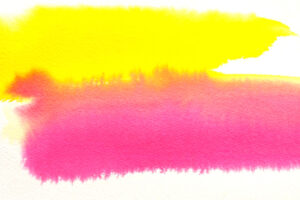
At a deeper level, most of the marks made by artistic tools such as a paintbrush, or pencil on paper, can be seen as very complex shapes (usually fractal). I’ll explain how simple and complex shapes and forms have a fascinating relationship with the evolution of the arts, and with watchmaking, below.
An interesting perspective from the other direction is the concept of elegance (which relates to aesthetics, as well as to other factors) in mathematical theorems, and in coding. G. H. Hardy described the characteristics of mathematical elegance as “seriousness, depth, generality, unexpectedness, inevitability, and economy.“
As usual, I will be looking at this subject from unusual perspectives, not just the typical accepted views.
Note . . . I only use watch images with permission from the watchmaker (unless the photos are public domain or creative commons), so some of the watches I present here might be lacking an image.
Mathematical Art: How Mathematics Can Be Used In Art.
Art and mathematics, seemingly distant disciplines, share an intricate and captivating relationship. The fusion of these seemingly distinct fields results in the creation of aesthetically pleasing and intellectually stimulating works that have enthralled humanity for centuries. Mathematics forms the structural backbone behind various artistic endeavors, enhancing their beauty and meaning. Here are some examples of ways mathematics can be used in art:
Tessellation:
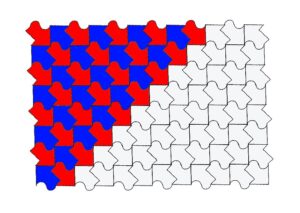
. . . the art of fitting shapes together without any gaps or overlaps, exemplify the harmonious blend of mathematics and art. Artists employ mathematical concepts to create mesmerizing patterns that repeat infinitely, such as M.C. Escher’s famous tessellations (more on those below). Through the utilization of geometric shapes like triangles, squares, and hexagons, these tessellations showcase the beauty of mathematical precision in art.
Symmetry:

a fundamental mathematical concept, finds profound expression in art across cultures and eras. Artists use symmetrical arrangements to create balance and harmony in their compositions, drawing inspiration from mathematical principles to evoke visual appeal and aesthetic pleasure. The human fascination with symmetry is evident in architectural designs, paintings, and sculptures, where symmetrical patterns and forms exude a sense of order and beauty.
Mandalas:
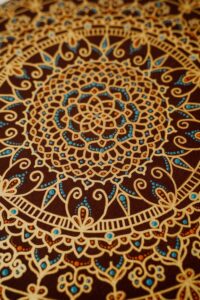
. . . geometric and often intricate patterns representing the universe in Hinduism and Buddhism, highlight the interconnectedness of mathematics and art. These circular designs radiate symmetry, employing mathematical principles to create mesmerizing patterns that reflect balance, unity, and spirituality. Mandalas, with their precise geometry, illustrate the fusion of mathematical concepts and artistic expression.
Geometry:
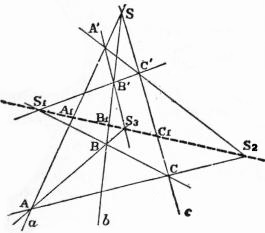
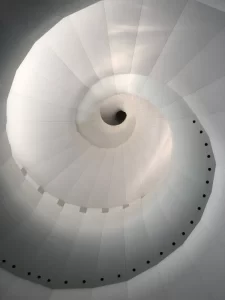
. . . the study of shapes, sizes, and properties, plays a pivotal role in the creation of patterns in art. Artists utilize geometric shapes and principles to design captivating patterns that mesmerize the viewer. From Islamic art’s intricate geometric patterns to the precise constructions in Renaissance art, geometry serves as a fundamental tool for artists to create visually appealing compositions.
Proportion:
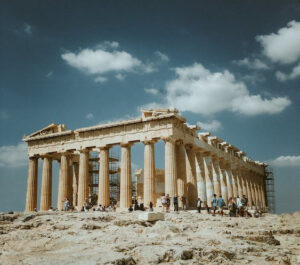
. . . another mathematical concept deeply ingrained in art, governs the relationships between different elements within an artwork. Artists use proportion to create a sense of realism and balance, ensuring that the sizes and placements of objects are harmonious. From the Golden Ratio seen in the architecture of the Parthenon (above) to Leonardo da Vinci’s “Vitruvian Man,” where human proportions align with mathematical precision, art embodies the mathematical principle of proportionality.
Perspective:
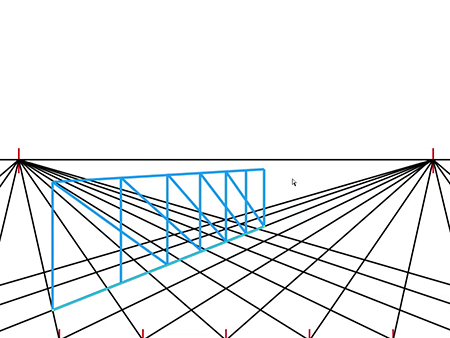

. . . a mathematical technique in art, enables artists to create the illusion of depth and three-dimensionality on a two-dimensional surface. Artists employ mathematical principles to accurately represent spatial relationships, allowing viewers to perceive depth and distance within artworks. Techniques like linear perspective, developed during the Renaissance, showcase how mathematics aids artists in portraying realistic scenes and environments.
Scale, the relative size of elements within an artwork, is another aspect where mathematics influences art. Artists use scaling to convey importance, depth, or emotions within their compositions. Mathematical principles help artists manipulate scale to evoke specific reactions from the viewers, whether it’s a monumental sculpture or a miniature painting, emphasizing the role of mathematics in art’s emotive power.
Color mixing:

. . . though seemingly more reliant on aesthetics, also has mathematical underpinnings. Artists understand color theory, which involves mathematical relationships between primary colors, their combinations, and the resulting hues. Utilizing principles such as the color wheel and understanding the properties of light, artists create visually stunning and harmonious color palettes that captivate audiences.
Another example of mathematics producing art is the Spirograph:
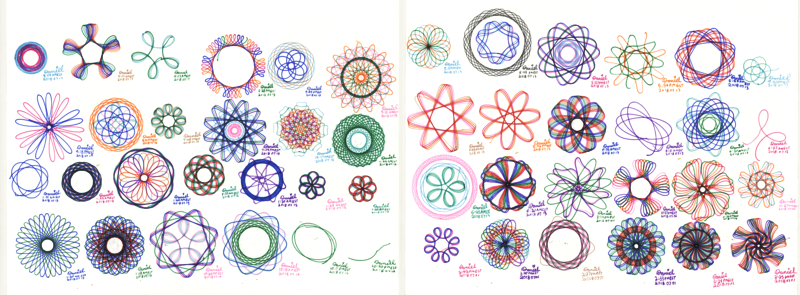
. . . a children’s toy which produces mathematical curves known as hypotrochoids and epitrochoids. “The well-known toy version was developed by British engineer Denys Fisher and first sold in 1965.” (Wikipedia)
The twin elliptic harmonograph is a more sophisticated version of the Spirograph, with a pen and a table, both of which oscillate at various speed ratios depending on weights. I loved the beautiful mathematical patterns created by one of these in the Science Museum, London (I am not sure if it is still there).
While computers have been used in art for decades, including creating fractal art (more on that, below), more recently, Artificial Intelligence has been involved in the creation of art, using a database of vast numbers of images, creating aesthetically pleasing works from its complex algorithms which are a form of mathematics.
The interplay between mathematics and art is a testament to the symbiotic relationship between logic and creativity. Mathematics provides a framework that artists use to create evocative, harmonious, and intellectually stimulating works that transcend time and culture, showcasing the profound integration of these two disciplines in the world of art.
Artists Who Use Mathematics
Art and mathematics have shared an intertwined relationship throughout history, inspiring artists to explore mathematical concepts and principles in their creative processes. The integration of mathematics into art has led to the emergence of visionary artists who incorporate mathematical theories, geometric shapes, algorithms, and numerical concepts in their artworks. From the Renaissance to contemporary times, numerous artists have utilized mathematics as a foundational element, adding depth, precision, and innovation to their artistic expressions.
One of the oldest known artists to consciously incorporate mathematics into his works was Ancient Greek High Classical Sculptor Polykleitos (Polyclitus) of Argos during the 5th Century BCE. Here is one of his sculptures:
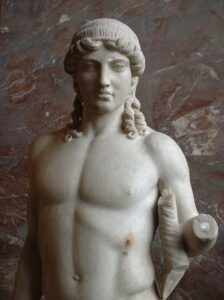
The famous Dutch artist M.C. Escher:
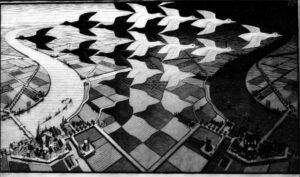
is renowned for his mind-bending works that intricately incorporate mathematical ideas, particularly tessellations, symmetry and transformation, often depicting impossible constructions. Escher’s prints often use interlocking shapes and patterns that seamlessly repeat without gaps or overlaps, showcasing the beauty of mathematical precision in art. His artworks, such as “Relativity” and “Drawing Hands,” challenge viewers’ perceptions of space, perspective, and logic, illustrating the intriguing fusion of art and mathematical concepts.
Bridging the realms of art and technology, the pioneer of algorithmic art, Manfred Mohr:
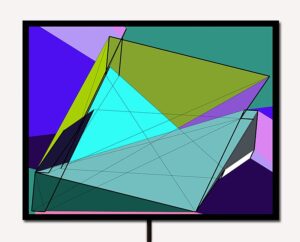
. . . employs mathematical algorithms and computer programming to generate geometric compositions. Mohr’s art relies on mathematical equations and algorithms to create intricate visual patterns and shapes. By utilizing computer code as his artistic medium, Mohr explores the aesthetics of mathematical concepts, producing mesmerizing digital artworks that exemplify the intersection of art, mathematics, and technology.
Another artist who delves into the realm of mathematics in art is Frank Stella:
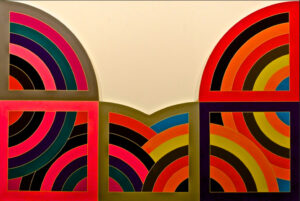
. . . known for his minimalist and geometric paintings. Stella’s artworks exhibit mathematical precision, employing symmetrical arrangements, geometric shapes, and intricate patterns. His series of “Black Paintings” and subsequent works demonstrate a deep engagement with mathematical principles, employing rigorous planning and mathematical structures to create visually striking and intellectually engaging compositions.
Bridget Riley:
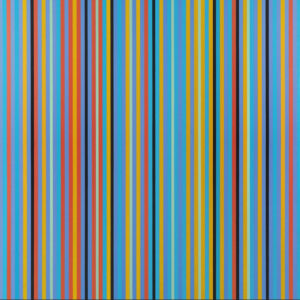
. . . a prominent figure in the Op Art movement, explores the dynamics of perception and optical illusions through her geometric and abstract paintings. Riley’s meticulous use of color, form, and precise geometric patterns creates visual effects that play with viewers’ perceptions, often evoking sensations of movement and depth. Her artworks, such as “Fall” and “Blaze 1,” demonstrate a fascination with mathematical concepts like symmetry, repetition, and the interaction of shapes and colors to create mesmerizing optical experiences.
The sculptor George W. Hart:
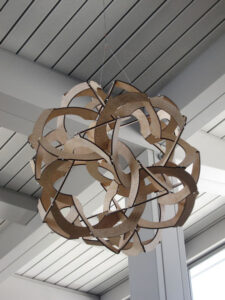
. . . combines mathematics with sculpture, creating intricate geometric forms that reflect mathematical beauty. Hart’s sculptures are based on mathematical principles like symmetry, tessellations, and polyhedra. Using various materials such as wood and metal, and employing 3D printing, he crafts mesmerizing sculptures that highlight the elegance and complexity of mathematical shapes, making abstract mathematical concepts tangible and visually captivating.
Contemporary artist and mathematician, Rafael Araujo:
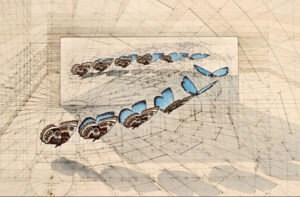
. . . intricately combines art and mathematics through his series of hand-drawn illustrations that depict the beauty of mathematical concepts such as the golden ratio, Fibonacci sequence, and logarithmic spirals. Araujo’s meticulously detailed illustrations of natural forms, particularly shells and insects, showcase the mathematical precision and symmetry inherent in nature, emphasizing the interconnectedness between mathematics and the natural world.
Paintings by Jackson Pollock:
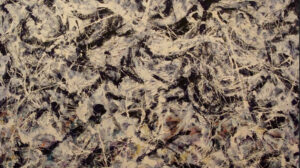
. . . have a fractal dimension, which means they can be seen as a line which is so complex that it starts to fill a two-dimensional plane, so their dimension is somewhere between a one-dimensional line and a two-dimensional plane. All fractals (see below) have a fractional dimension rather than one with a whole number (integer).
Geometric abstraction, a significant movement in modern art, focuses on creating compositions using precise geometric shapes, lines, and forms devoid of representational or figurative elements. Artists within this movement seek to emphasize pure form, color, and spatial relationships, often employing mathematical precision and strict geometric arrangements in their artworks. For example:
Kazimir Malevich:
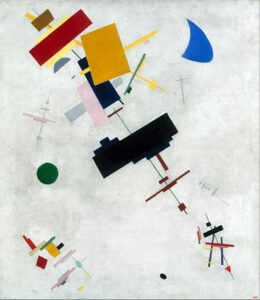
. . . a pioneering figure in geometric abstraction, is renowned for his iconic painting “Black Square” (1915), a radical departure from representational art. Malevich’s exploration of basic geometric shapes, particularly squares and rectangles, aimed to express spiritual and cosmic ideals through simplified forms.
Another notable artist associated with geometric abstraction is Piet Mondrian:
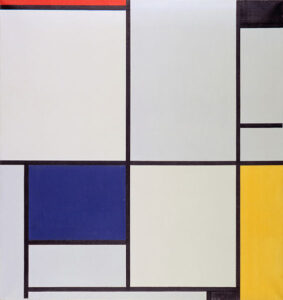
His series of paintings featuring grids, intersecting lines, and primary colors exemplify the movement’s principles. Mondrian’s iconic “Composition” series, such as “Composition with Red, Blue, and Yellow” (1930), embodies the harmony achieved through the balance of geometric elements and primary colors within a grid structure.
Theo van Doesburg:
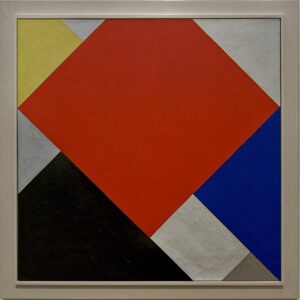
. . . a key figure in the De Stijl movement, also contributed significantly to geometric abstraction. His works emphasized the use of straight lines, right angles, and primary colors, seeking to achieve visual harmony and order through geometric compositions. Van Doesburg’s “Composition VIII” and “Contra-Construction Project” demonstrate his commitment to geometric abstraction’s principles.
Beautiful data visualizations add another perspective to the intersection of mathematics and art, presenting data in ways which not only make it easier to comprehend the data shown, but also offer stunning aesthetics.
These artists represent a fraction of the many creative minds who have embraced mathematics as a source of inspiration, utilizing its principles, patterns, and structures to enrich their artistic expressions. Their contributions highlight a few of the diverse ways in which mathematics intersects with art. Through their visionary works, these artists continue to illuminate the profound and enduring relationship between mathematics and art, captivating audiences and fostering appreciation for the beauty of both disciplines.
The Golden Ratio In Art
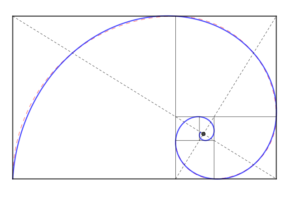
A great example of mathematics in art is a ratio of 1 to 1.618, called the “golden ratio”, which creates a balanced relationship that very pleasing visually. It is the ratio between two numbers that are next to each other in the Fibonacci sequence, getting closer to the precise golden ratio the higher you go in the sequence.
The Fibonacci sequence:

. . . a mathematical pattern where each number is the sum of the two preceding ones, appears in nature and in the arts.
The Golden Ratio is also commonly found in nature, such as:
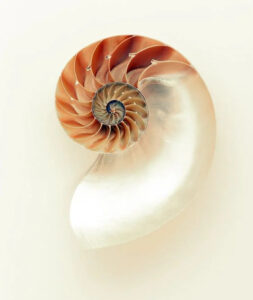

- Chameleon tails.
- Romanesco broccoli
- The shells of snails and seashells.
- Fern fiddleheads.
- The horns of rams
- Spiral galaxies.
- Ocean waves.
- Flower buds.
- Sunflower seeds.
- And many more.
It is found in “The Creation of Adam” by Michelangelo:
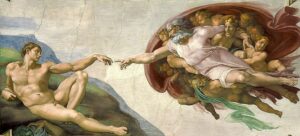
. . . which is on the ceiling of the Sistine Chapel.
Leonardo da Vinci’s iconic drawing, the “Vitruvian Man”:
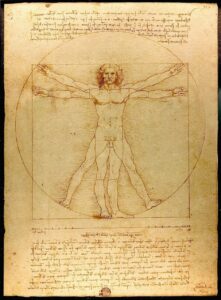
. . . exemplifies the integration of art and mathematics, showcasing the human body’s proportional harmony based on the Golden Ratio. Da Vinci’s exploration of mathematical concepts, alongside his artistic brilliance, established him as a pioneer in bridging the gap between art and mathematics.
The Golden Ratio is also found in:
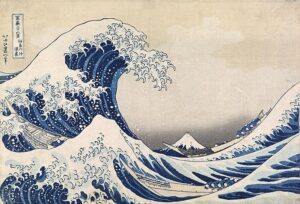
- “Mona Lisa” by Leonardo Da Vinci.
- The proportions of the Parthenon (which we saw earlier in this article).
- “The Great Wave off Kanagawa” by Katsushika Hokusai (above)
- “The Sacrament of The Last Supper “by Salvador Dali
I’ll look at another area where the golden ratio is used, below.
Mathematical Art And Watchmaking.
Engineering is fundamentally about mathematics.
Mathematics plays a pivotal role in the intricate design and precise functioning of mechanical watch movements. Behind the elegance of a wristwatch lies a complex system of gears, springs, and components meticulously crafted to measure time with accuracy. The application of mathematical principles governs the harmony and synchronization of these elements, ensuring their seamless operation, and would often be implemented, at least partly, by algorithmic design in todays watchmaking.
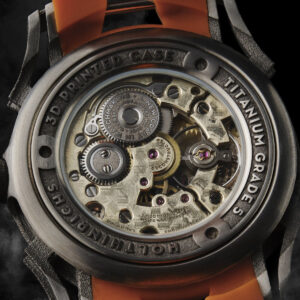
At the heart of a watch movement are gears, each with carefully calculated sizes, shapes, and ratios. Mathematical formulas dictate the tooth counts and gear ratios necessary for accurate timekeeping, such as can be seen in the beautiful example of the back of a Holthinrichs watch (above). Gear trains, composed of interlocking gears, transmit energy from the mainspring to the escapement, regulating the release of energy and controlling the movement of hands. The gear ratios in these mechanisms are calculated with precision to determine the speed at which each gear turns, translating into the proper movement of the watch hands.
The escapement, a critical component, utilizes mathematical principles to regulate the release of energy from the mainspring in precise intervals. Its design involves intricate geometry and calculations to ensure consistent and accurate timekeeping. The escapement’s oscillations, governed by mathematical equations, control the movement of the gear train, dividing time into equal segments.
The A. Lange & soehne tourbograph perpetual, “pour le mérite” is a fine example of beautiful engineering design:
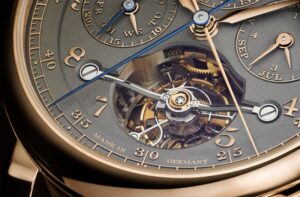
Mathematics also plays a role in the design of balance wheels and springs, crucial for maintaining the watch’s accuracy. Calculations involving oscillations, frequency, and amplitude are fundamental in determining the ideal dimensions and material properties required for these components. Engineers use mathematical models to predict and fine-tune the behavior of these elements, ensuring optimal performance and reliability.
Advancements in mathematics have contributed to the development of computer-aided design (CAD) software, enabling horologists to simulate, model, and refine watch movements with exceptional precision. This technology allows for intricate calculations and adjustments, streamlining the design process and enhancing the overall performance of mechanical watches.
Mathematics is the cornerstone in the design and functionality of mechanical watch movements.
Watches through most of their history were mainly based on functionality, such as the engineering involved in mechanical movements we looked at above, but engineering, and the mathematics behind it, are now often used for visual impact, which makes their function more about art than engineering, and there are many enthusiasts eager for something unusual, mechanically interesting and visually stunning.
Here are some examples of aesthetically fascinating watches with a strong engineering influence:
The Cartier Rotonde de Cartier Skeleton Mysterious Double Tourbillon:
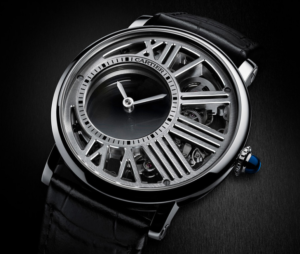
. . . is a beautiful examples of creative engineering-influenced design, with the enlarged roman numerals becoming an aesthetically focused part of the metal structure around the off-center dial.
Devon Watches Tread 1:
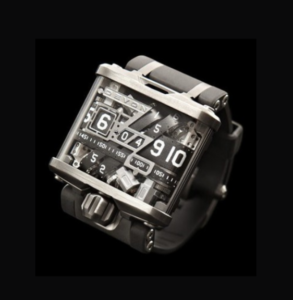
The Devon Tread 1 uses a patented system of interwoven time belts to display the time. While not a mechanical watch in the traditional sense, because it uses an electronic microcontroller and a rechargeable battery instead of a spring for power, it is still very much a fascinating and visually stunning innovation in mechanical time-display. Its creativity is outstanding both from a technical point of view and from the perspective of how the innovative engineering aligns with the unique aesthetics.
The HM9 Sapphire Vision from MB&F:
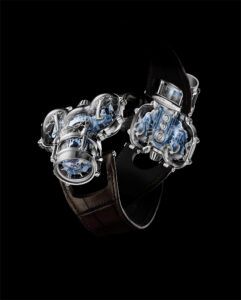
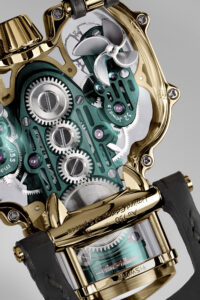
. . . is visually extraordinary as well as being technically impressive, and was made available to the public in four limited editions, with just five pieces each. Made as “a tribute to the extraordinary automotive and aeronautic designs of the 1940s and 50s. The result was a case like no other that echoed the epoch’s flowing, aerodynamic lines.“
They decided to present their amazing and beautiful movement encased in “an outer hull of sapphire crystal and precious metal.” An outstanding example of beautiful and fascinating engineering
There are a few watches use mathematical symbols as decoration. An example is the The Fortis 2pi watch (no longer shown on their website), which has geometric symbols, angles and the letter Pi, on a dial surface similar to a whiteboard.
Humism watches:
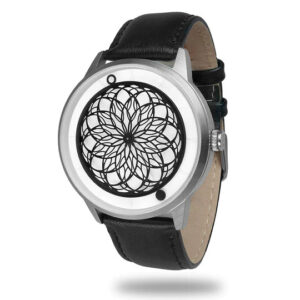
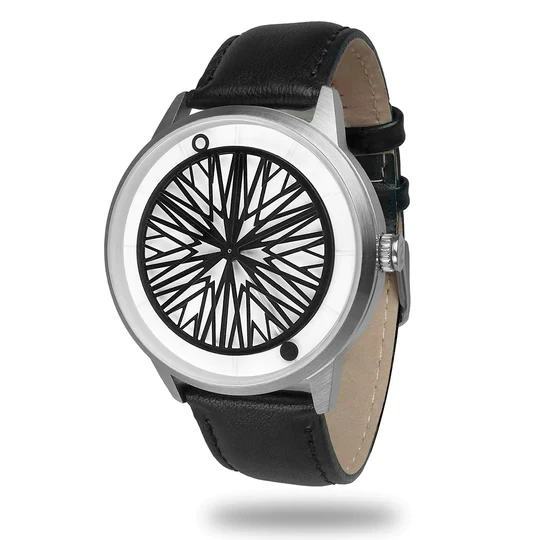
. . . by an independent design studio based in Singapore, have kinetic sculptures showing moving mathematical patterns, resulting in a unique watch aesthetic. They say “Inspired by the watch as an artistic medium, we seek to create beauty out of time’s movement.“
The Golden Ratio In Watchmaking:
. . . has captivated artists, architects, and designers for centuries due to its perceived aesthetic harmony and proportion. In the realm of watchmaking, this mathematical ratio finds application in the design, construction and layout of timepieces, contributing to their visual appeal and ergonomic functionality.
One of the primary areas where the Golden Ratio is employed in watchmaking is in the design of watch dials. The division of the dial into sections based on the Golden Ratio guides watch designers in creating aesthetically pleasing and balanced layouts. Elements such as hour markers, sub-dials, hands, and other complications often adhere to these proportions, creating a visually harmonious arrangement that is both functional and appealing to the eye.
The case proportions of timepieces also frequently adhere to the Golden Ratio, contributing to the overall balanced appearance of the watch.
Some watchmakers consciously integrate this mathematical principle into their designs, such as these . . .
A great example of the use of the Golden ratio in watchmaking, is Jaeger-LeCoultre’s Reverso:
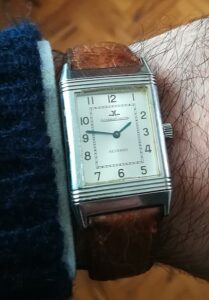
The original was created in 1931 at the height of the Art Deco artistic movement, it uses the Golden Ratio is recognised as a universal signifier of beauty and harmony.
The Golden ratio also influenced the case of Patek Philippe’s Golden Ellipse, launched in 1968.
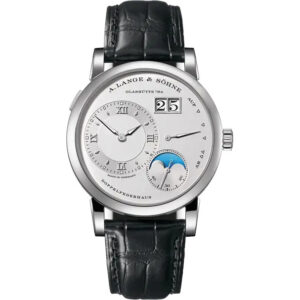
. . . also uses the ratio, in the proportions of the hour and minute circle in relation to the diameter of the dial.
The Bianchet Tourbillon B1.618 Openwork:
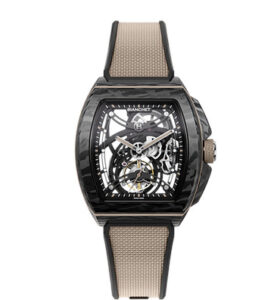
. . . designed by Mr. Festa Bianchet who’d been interested by the uses of the Fibonacci sequence to predict changes in foreign exchange rates. So, he said, “it popped up in my mind that we could use the ratio in the watch.”
The Transition Of Focus From Simple Symbols To Complex Reality
The evolution of the Western Art Tradition can be seen as recently undergoing a major change. Read my blog post on what I see as the biggest revolution in the Western Art Tradition for full details of this fascinating development (that no-one seems to have noticed).
To summarize it briefly, all visual art before abstract art focused on objects with names, such as people, places, animals etc. And the focus of music until the 20th Century was on notes, which are symbols for sounds. To put it more precisely, after more than a thousand years of being based on a focus on concepts which can described by very simple data, to a focus on things which need very much more complex sets of data to represent them effectively.
An example of mathematics in art, after this revolution, is fractal art, such as the 3D Mandelbulb fractal:
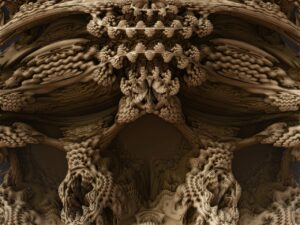
Although a fractal can be defined by a relatively simple set of data, the results of applying that data are literally infinite in possible detail.
Similarly, while a non-abstract painting has a focus on things which can be summarized in a few words, there are no simple words that do justice to the complexity of the marks that an abstract painting, such as a Rothko (below), are fundamentally about.
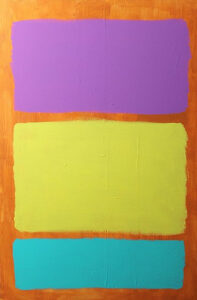
This same transition is reflected in the difference between fine jewelry, which is mostly about simple geometric shapes and forms, smooth, polished surfaces, compared to art jewelry, which is about forms and textures which are often complex, rough, broken, and fractal in nature, like the world around us.
This change can be seen in some recent watchmaking . . .
Complex Mathematics In Watch Visual Design
While there are a lot of visually stunning watches (a few of which we looked at above), most of them have conventional engineering (based on relatively simple mathematics) as the main influence on their visual design, even when they present new engineering functionality, along with the principles from fine jewelry, such as using simple geometric forms, smooth polished surfaces and precious metals.
There are now a few watches which have influences which align with the expansion into art jewelry concepts, such as using forms and surfaces which are complex, organic, broken or fractal in nature. These relate to much more complex mathematical principles than the simple geometric concepts used in most watches until recent decades, reflecting the same transition that the arts have undergone, as I outlined above.
For example:
The Cartier Crash Tigrée watch has strong art-jewelry influence as well as some fine jewelry influence while retaining conventional watch hands.
The DB28 XP Météorite by De Bethune has a beautiful dial with a significant art-jewelry influence of irregular shapes and marks, with conventional case and hands:
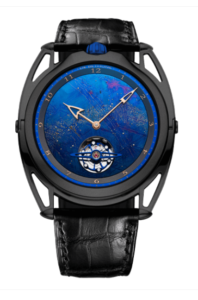
Fractals, discovered in the age of computing, have been used to create fascinating examples of mathematical art, both in two dimensions, and three, as well as video and other art-forms (more on the use of fractals in the art, here).
While 3D fractals have been used in areas like sculpture and jewelry, as far as we know, UnconstrainedTime have produced what is almost certainly the first ever 3D fractal watch:
For more detail on that subject, see our blog post 3D Fractal Watch: The First Of Its Kind?
Don’t miss our launch!
. . . make sure you subscribe to our Priority List for notifications.
What is the most interesting use of mathematical art in watchmaking, to you? We’d love to know . . . tell us in the comments below or in our social media.

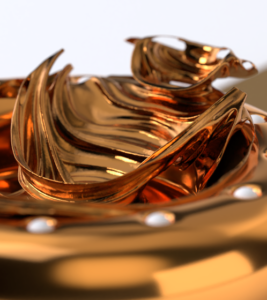
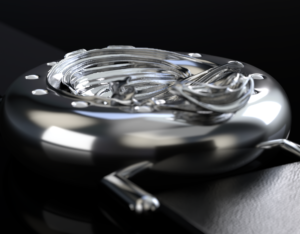
Leave a Reply